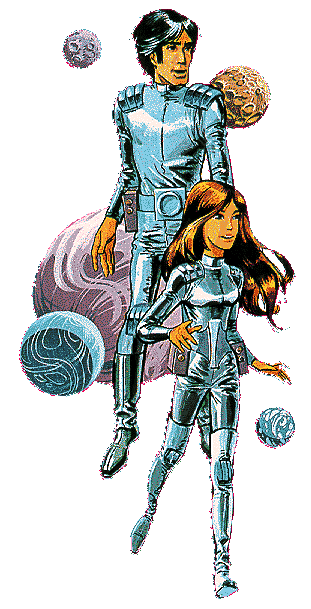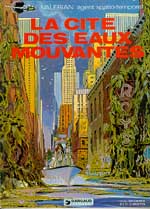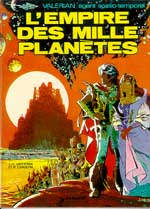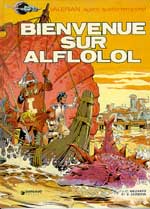


Writer: Pierre Christin (1938- )
Artist: Jean-Claude Mezieres (1938- )
Valerian is an agent for the space-time
police of Galaxity, the powerful Terran
empire from the year 2770. His companion is the red-haired Laureline, originally from medieval France. In episodes 13 and 14, Galaxity's future is erased by powerful
time-manipulating aliens, stranding Valerian
and Laureline in our present.
The Stories
from "Pilote" Magazine
0. Les Mauvais Reves [The Bad Dreams]
(30 p.) (PI Nos. 420-434, 1967)
1a. La Cite des Eaux Mouvantes [The City Of The Moving Waters] (28 p.) (PI Nos. 455-468, 1968)
1b. Terre en Flammes [Earth In Flames]
(28 p.) (PI Nos. 492-505, 1969)
2. L'Empire des Mille Planetes [The Empire Of A Thousand Planets] (44 p.) (PI Nos. 520-541, 1970)
3. Le Pays Sans Etoiles [World Without Stars]
(46 p.) (PI Nos. 570-592, 1971)
4. Bienvenue sur Aflolol [Welcome To Alflolol]
(46 p.) (PI Nos. 632-653, 1972)
5. Les Oiseaux du Maitre [The Birds Of The Master]
(46 p.) (PI Nos. 710-722, 1973)
6. L'Ambassadeur des Ombres [The Ambassador Of The Shadows] (46 p.) (Nouveau PI Nos. 14-17, 1975)
7. Sur les Terres Truquees [On The Fixed Earths]
(1977)
8. Les Heros de l'Equinoxe [The Heroes Of The Equinox]
(1978)
9. Metro Chatelet Direction Cassiopee (1980)
10. Brooklyn Station Terminus Cosmos (1981)
11. Les Spectres d'Inverloch [The Ghosts Of Inverloch]
(1984)
12. Les Foudres d'Hypsis [The Thunder Of Hypsis]
(1985)
13. Sur Les Frontieres [On The Borders]
(1988)
14. Les Armes Vivantes [The Living Weapons]
(1990)
15. Les Cercles du Pouvoir [The Circles Of Power]
(1994)
16. Les Otages de l'Ultralum [The Hostages Of The Ultralum] (1996)
17. L'Orphelin des Astres [The Orphan From The Stars]
(1998)
18. Par des Temps Incertains [In Uncertain Times]
(2001)
19. Au Bord du Grand Rien [At the Edge of the Great Nothing] (2004)
Hors-Serie
1. Par les Chemins de l'Espace [Across The Pathways Of Space] (1979, digest-size softcover; contains five 16 p. short stories published in "Super
Pocket Pilote":
a) Le Flumgluff de l'Amitie [The Flumgluff of Friendship]
(SPP 8, 1970);
b) Tsirillitis l'Asteroide [Tsirillitis the Asteroid]
(SPP 5, 1969);
c) Les Engrenages d'Uxgloa [The Cogs of Uxgloa]
(SPP 4, 1969);
d) La Planete Triste [The Sad Planet]
(SPP 6, 1969);
e) Triomphe de la Technique [Triumph of Technology]
(SPP 9, 1970))
2. Mezieres et Christin Avec... [Mezieres & Christin With...] (1985, hardcover; reprinting Episode 0; an unpublished "video comic", Les Asteroides
de Shiballil [The Asteroids of Shimballil],
and some non-Valerian stories)
3. Valerian Omnibus (1986, hardcover; reprinting Eps. 1, 2a and 2b, and the last two 16 p. short stories published
in "Super Pocket Pilote" not reprinted in 1 above:
f) Le Grand Collectionneur [The Great Collector]
(SPP 3, 1969),
g) Droles de Specimens [Funny Specimens]
(SPP 7, 1970)
4. Les Habitants du Ciel - Atlas Cosmique de Valerian & Laureline [The
Inhabitants of the Sky - Valerian & Laureline's Cosmic Atlas] (1991)
5. Les Habitants du Ciel Volume 2 - Atlas Cosmique de Valerian & Laureline [The
Inhabitants of the Sky - Valerian & Laureline's Cosmic Atlas] (1999)





|
The next two books, Metro Chatelet Direction Cassiopea and Brooklyn Station Terminus Cosmos,
show Valerian travelling to the 1980s
to explore the mysterious appearances of alien, elemental forces. Laureline discovers that the key to this cosmic plot is to be found in Cassiopea in the future.
|
|
|
|
In addition to these full-length stories, there were seven shorter Valerian stories published in the early 1970s in the digest-sized, quarterly "Super Pocket Pilote". These were collected in The Pathways of Space, and the more recent Valerian Omnibus volume. An original Valerian story, The Asteroids of Shimballil, was also prepared for an animated video production. Drawings for the first episode were published in the Mezieres & Christin collection. |
|
VALERIAN in the U.S.A.
|
|
The Authors
 Pierre Christin. When he created Valerian, writer Pierre Christin, a childhood friend of artist Jean-Claude Mezieres, had already penned a number of short stories under the pseudonym of "Linus." Another,
more recent, collaboration with Mezieres,
is the futuristic thriller Canal-Choc.
Christin's other famous genre series include the grim and political Légendes
d'Aujourd'hui [Modern Legends] drawn by Enki Bilal
and Les Leçons du Prof. Bourremou
[The Teachings of Prof. Bourremou] with
Francois Boucq. Christin is also a distinguished
science fiction novelist.
Pierre Christin. When he created Valerian, writer Pierre Christin, a childhood friend of artist Jean-Claude Mezieres, had already penned a number of short stories under the pseudonym of "Linus." Another,
more recent, collaboration with Mezieres,
is the futuristic thriller Canal-Choc.
Christin's other famous genre series include the grim and political Légendes
d'Aujourd'hui [Modern Legends] drawn by Enki Bilal
and Les Leçons du Prof. Bourremou
[The Teachings of Prof. Bourremou] with
Francois Boucq. Christin is also a distinguished
science fiction novelist. |
|
|
|
 French artist Jean-Claude Mezieres (1938-
) attended the same art school as Moebius
in the 1950s. He joined the editorial team of "Pilote" in the early 1960s, and co-created Valerian, the most popular SF series in French comics, with Christin in 1967. He also supervised Canal-Choc in 1990.
French artist Jean-Claude Mezieres (1938-
) attended the same art school as Moebius
in the 1950s. He joined the editorial team of "Pilote" in the early 1960s, and co-created Valerian, the most popular SF series in French comics, with Christin in 1967. He also supervised Canal-Choc in 1990. |